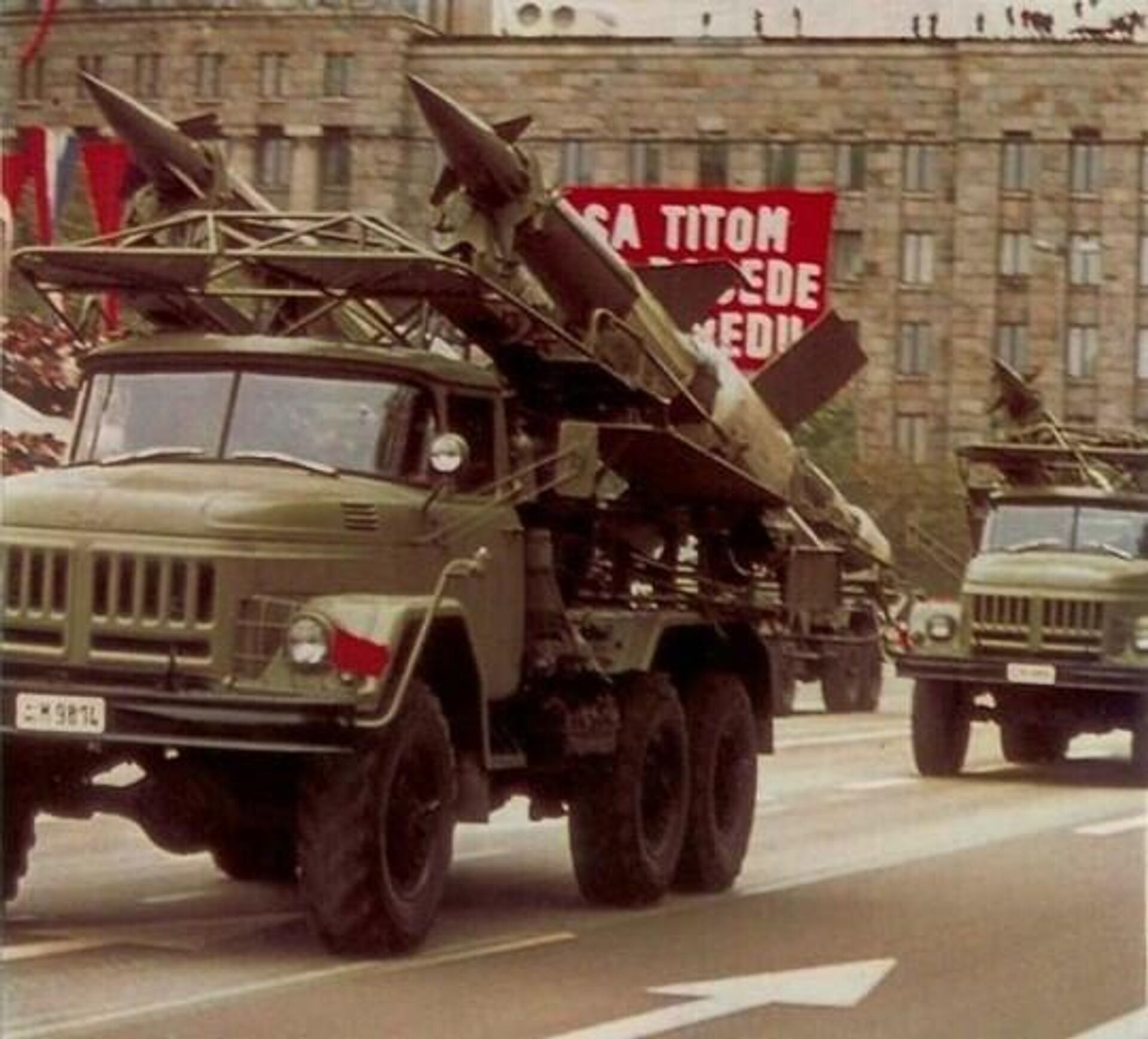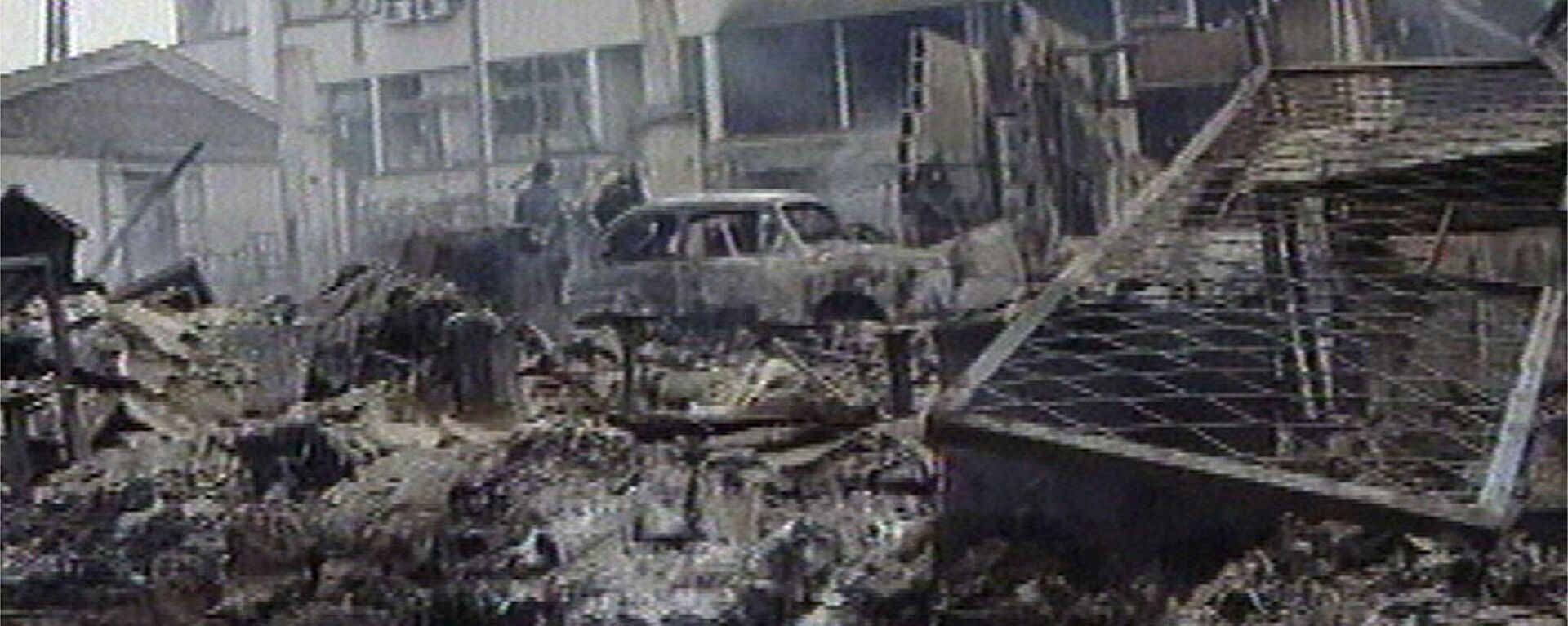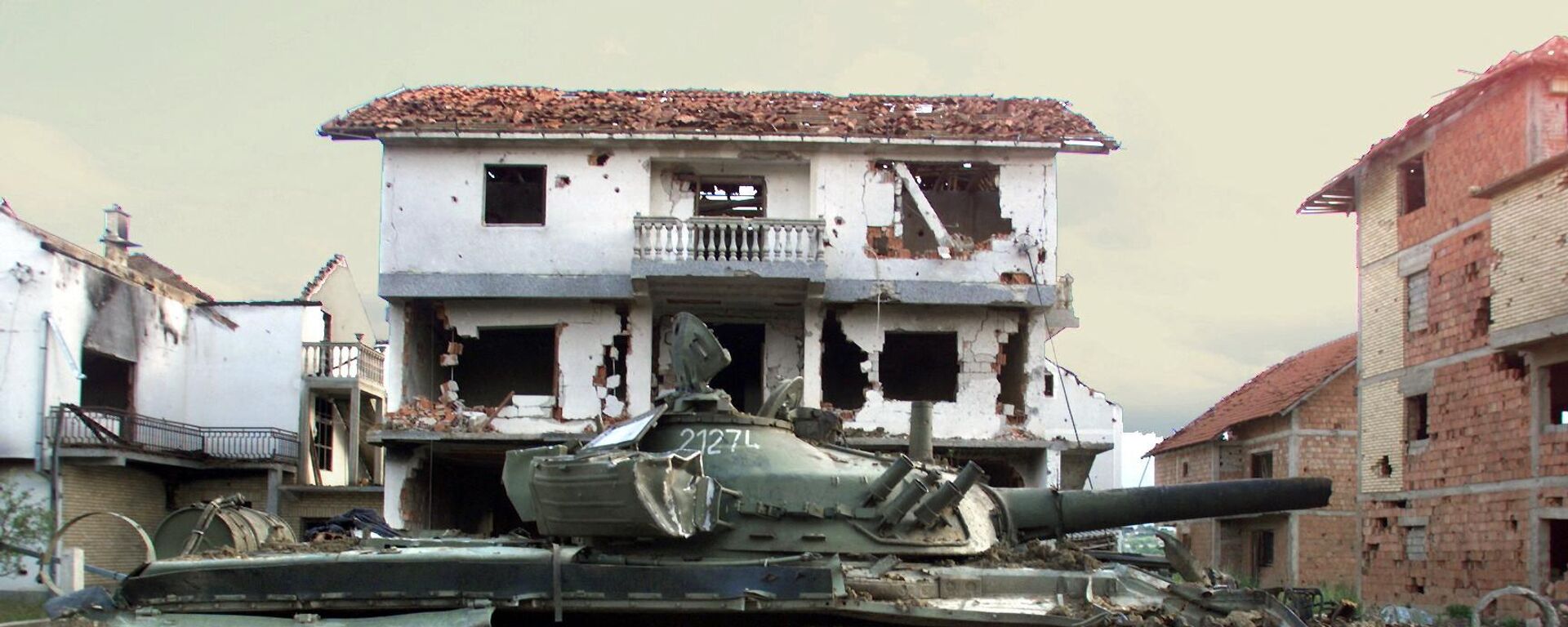https://sputnikglobe.com/20240327/how-yugoslavia-shot-us-f-117-stealth-bomber-program-down-into-early-retirement-1117588928.html
How Yugoslavia Shot US F-117 Stealth Bomber Program Down Into Early Retirement
How Yugoslavia Shot US F-117 Stealth Bomber Program Down Into Early Retirement
Sputnik International
Sunday marked the 25th anniversary of the start of NATO’s 78-day campaign of aerial aggression against Yugoslavia. Just three days in, the Yugoslav Army shot down a $111 million F-117 Nighthawk using a vintage Soviet missile. Sputnik asked former US Air Force Lieutenant Colonel Karen Kwiatkowski how such a thing could happen.
2024-03-27T19:14+0000
2024-03-27T19:14+0000
2024-03-27T19:27+0000
military
karen kwiatkowski
military & intelligence
yugoslavia
nato
us air force
pentagon
ussr
https://cdn1.img.sputnikglobe.com/img/101991/81/1019918121_0:169:2040:1317_1920x0_80_0_0_1d2909fb3ebc09a3b9a281c25deed463.jpg
On March 27, 1999, a Yugoslav air defense unit downed a US Air Force Lockheed F-117 Nighthawk attack aircraft using a Soviet-made S-125 Neva (NATO reporting name SA-3 Goa) SAM, making history and marking the first-ever destruction of a stealth aircraft in combat.When first unveiled in the 1980s, the Pentagon thought they had gotten their hands on a nearly invincible invisible aircraft, with the $111 million F-117 featuring a futuristic and high-tech radar-wave scattering paint job, unique angular shape and special radar-resistant coating. Among other things, the jet was meant to penetrate deep into the USSR’s air defenses and carry out nuclear strikes if the Cold War ever went hot. In the popular imagination, US 80s stealth technology, including the F-117 and the Northrop Grumman B-2 Spirit, were presented as something akin to superweapons - capable of winning a war against Moscow single-handedly.That sense of smug superiority at the Pentagon evaporated overnight twenty-five years ago, when the 3rd Battery of the 250th Missile Brigade of the Yugoslav Air Defense Forces commanded by Colonel Zoltan Dani took up duty near Buđanovci, Serbia, Yugoslavia.Dani and his men monitored the F-117 during flight using meter-range radar, which proved capable of detecting the stealth aircraft more easily than expected. “It was only when the aircraft was 15 meters away that I commanded to lock on the target and ordered Senad Muminovich, the gunner, to press the launch button, and the missile was fired,” Dani recalled in an interview with Sputnik in 2019.The footage of Buđanovci residents dancing on the wings of the downed aircraft while chanting “Sorry, we didn’t know it was invisible” spread like wildfire across the world and became a major blow for the NATO coalition, giving Yugoslavs the strength to continue resisting the West’s aggression.Over 20 years later, in December 2020, Lieutenant Colonel Charlie Hainline, another F-117 pilot who took part in the bombing of Yugoslavia, revealed that a second F-117 piloted by his wingman had been hit by Yugoslav anti-aircraft fire, taking serious damage but managing to limp back to base.Shock“I vaguely recall this as being a shock – it was the premier stealth aircraft of the day,” retired US Air Force Lieutenant Colonel and former senior DoD analyst Karen Kwiatkowski told Sputnik, recalling the March 27, 1999 incident.The S-125’s capabilities aside, Kwiatkowski said the NATO operation’s “lax” security contributed to the F-117’s destruction, as did the US Air Force’s complacency “in comparing the high-tech F-117 and its newer stealth technology with the ‘enemy’ capabilities. This complacency came from looking at the war (and the world) purely from a technological level. After all, most Americans and those in the military believed that it was solely and mainly a recognition of US military and technological superiority that caused the dissolution of the Soviet Union.”“Yugoslavia itself was viewed as a ‘safe’ war against a weak enemy,” with the aerial aggression against it meant to ‘demonstrate US values’ “rather than fighting to preserve or win anything,” the Air Force vet said.The March 27, 1999 incident over Buđanovci “debunked” the myth of invincible stealth technology sold to the US government by Lockheed, and forced the US and other major air powers to continue to refine the tech, while ramping up operational security in the US Air Force, Kwiatkowski said.Otherwise, unfortunately, the decades since the incident have “changed little in the US approach to using its military establishment around the world, beyond millions of dead people in other countries,” the observer summed up.
https://sputnikglobe.com/20201202/former-stealth-fighter-pilot-confirms-yugoslavs-hit-second-us-f-117-during-1999-war-1081339775.html
https://sputnikglobe.com/20240327/cancer-incidence-mortality-after-nato-bombing-of-yugoslavia-still-on-rise---serbian-health-minister-1117571639.html
https://sputnikglobe.com/20240324/natos-bombing-of-yugoslavia-sulmination-of-negligence-of-international-law-1117529198.html
yugoslavia
ussr
Sputnik International
feedback@sputniknews.com
+74956456601
MIA „Rossiya Segodnya“
2024
News
en_EN
Sputnik International
feedback@sputniknews.com
+74956456601
MIA „Rossiya Segodnya“
Sputnik International
feedback@sputniknews.com
+74956456601
MIA „Rossiya Segodnya“
why was the f-117 retired, how did yugoslavia shoot down a stealth bomber, did yugoslavia shoot down a stealth bomber
why was the f-117 retired, how did yugoslavia shoot down a stealth bomber, did yugoslavia shoot down a stealth bomber
How Yugoslavia Shot US F-117 Stealth Bomber Program Down Into Early Retirement
19:14 GMT 27.03.2024 (Updated: 19:27 GMT 27.03.2024) Sunday marked the 25th anniversary of the start of NATO’s 78-day campaign of aerial aggression against Yugoslavia. Just three days in, the Yugoslav Army shot down a F-117 Nighthawk using a vintage Soviet missile. Sputnik asked former US Air Force Lieutenant Colonel Karen Kwiatkowski how such a thing could happen.
On March 27, 1999, a Yugoslav air defense unit downed a US Air Force Lockheed F-117 Nighthawk attack aircraft using a Soviet-made S-125 Neva (NATO reporting name SA-3 Goa) SAM, making history and marking the first-ever destruction of a stealth aircraft in combat.
Introduced into service a little over four decades ago in late 1983, the last of the US Air Force’s F-117 fleet was consigned to semi-retirement just 25 years later in 2008, allegedly because new and better stealth aircraft had become available, but really because the plane was rendered instantaneously obsolete after being destroyed by a Soviet SAM designed in the 1950s to take on second-generation jet fighters.
When first unveiled in the 1980s, the Pentagon thought they had gotten their hands on a nearly invincible invisible aircraft, with the
$111 million F-117 featuring a futuristic and high-tech radar-wave scattering paint job, unique angular shape and special radar-resistant coating. Among other things, the jet
was meant to penetrate deep into the USSR’s air defenses and carry out nuclear strikes if the Cold War ever went hot. In the
popular imagination, US 80s stealth technology, including the F-117 and the Northrop Grumman B-2 Spirit, were presented as something akin to superweapons - capable of winning a war against Moscow single-handedly.
That sense of smug superiority at the Pentagon evaporated overnight twenty-five years ago, when the 3rd Battery of the 250th Missile Brigade of the Yugoslav Air Defense Forces commanded by Colonel Zoltan Dani took up duty near Buđanovci, Serbia, Yugoslavia.
Dani and his men monitored the F-117 during flight using meter-range radar, which proved capable of detecting the stealth aircraft more easily than expected. “It was only when the aircraft was 15 meters away that I commanded to lock on the target and ordered Senad Muminovich, the gunner, to press the launch button, and the missile was fired,” Dani
recalled in an interview with Sputnik in 2019.
Confirming the hit, “we congratulated each other and that was it. The feeling was very good, as if we scored in a very important [sporting] match. In the morning, an officer from high command came; he congratulated us and asked if we knew what we had shot down. I answered ‘I have no idea, some target’. And then the officer told us it was an F-117,” the officer said.
The footage of Buđanovci residents dancing on the wings of the downed aircraft while chanting “Sorry, we didn’t know it was invisible” spread like wildfire across the world and became a major blow for the NATO coalition, giving Yugoslavs the strength to continue resisting the West’s aggression.
Over 20 years later, in December 2020, Lieutenant Colonel Charlie Hainline, another F-117 pilot who took part in the bombing of Yugoslavia,
revealed that a second F-117 piloted by his wingman had been hit by Yugoslav anti-aircraft fire, taking serious damage but managing to limp back to base.

2 December 2020, 19:33 GMT
“I vaguely recall this as being a shock – it was the premier stealth aircraft of the day,” retired US Air Force Lieutenant Colonel and former senior DoD analyst Karen Kwiatkowski told Sputnik, recalling the March 27, 1999 incident.
“The US and NATO Yugoslavia campaign was seen by us as to be ‘easy’ in that it was largely an air operation allied with one side of a civil war, a standoff effort against Soviet-era weapons in a post-Soviet era. Yet tactics and poor US/NATO operational security led to this surprise. I was surprised, because this was 25 years ago, and I was part of the world’s best air force,” Kwiatkowski, who left the Pentagon and became a whistleblower over the 2003 Iraq War, said.
The S-125’s capabilities aside, Kwiatkowski said the NATO operation’s “lax” security contributed to the F-117’s destruction, as did the US Air Force’s complacency “in comparing the high-tech F-117 and its newer stealth technology with the ‘enemy’ capabilities. This complacency came from looking at the war (and the world) purely from a technological level. After all, most Americans and those in the military believed that it was solely and mainly a recognition of US military and technological superiority that caused the dissolution of the Soviet Union.”
“Yugoslavia itself was viewed as a ‘safe’ war against a weak enemy,” with the aerial aggression against it meant to ‘demonstrate US values’ “rather than fighting to preserve or win anything,” the Air Force vet said.
But technology was not enough to break the spirt of Colonel Dani and his men, Kwiatkowski said. “Colonel Dani was a baker by trade, fighting for his country, his family, his people and his land. His opponent was simply doing a ‘fun’ job, as directed, and hoping for a good story to tell later. We have seen this kind of thing in any number of wars, past and present, where innovative use of whatever you have at hand – in terms of fighters, intelligence, networks, weapons and tools of every kind –can have major consequences on the battle landscape.”
The March 27, 1999 incident over Buđanovci “debunked” the myth of invincible stealth technology sold to the US government by Lockheed, and forced the US and other major air powers to continue to refine the tech, while ramping up operational security in the US Air Force, Kwiatkowski said.
“The US military downplayed the negative publicity, and the contractors had fresh cause to request more funding for years to come. I don’t have the impression that the overall US military leadership gained any respect for the ‘enemy’ and their Soviet-era air defense, but I do think F-117 pilots did,” Kwiatkowski emphasized.
Otherwise, unfortunately, the decades since the incident have “changed little in the US approach to using its military establishment around the world, beyond millions of dead people in other countries,” the observer summed up.






